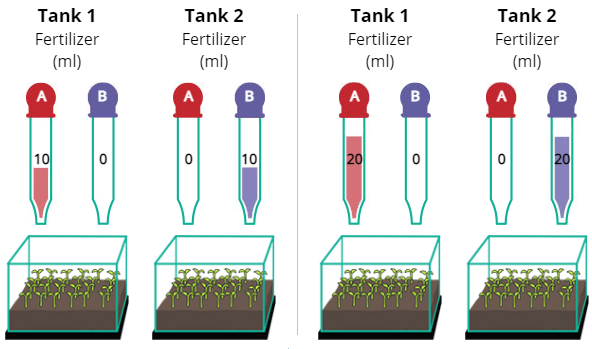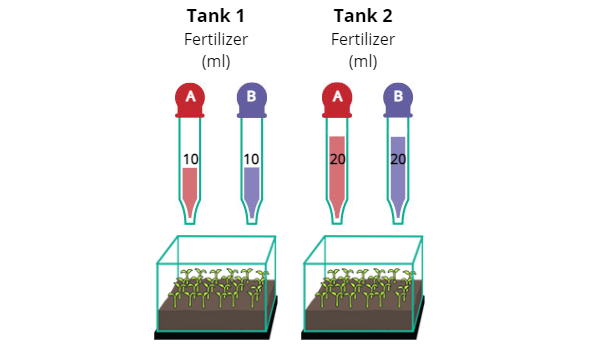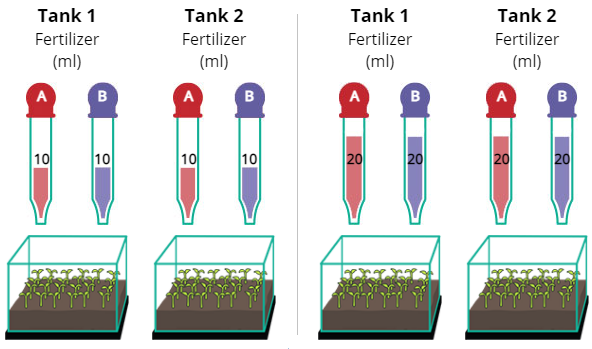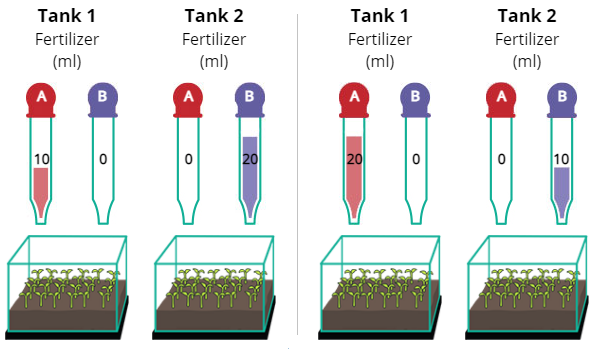Pepper Plants
Screen 4 – Experimental Setup: Fertilizer
On Screen 4, students implemented their experimental design by deciding how much of each of the two fertilizers to add to each tank—20 ml, 10 ml, or 0 ml. To set up the fertilizer combination for a tank, students selected (clicked) the tank and were directed to a screen specific to that tank. In this new screen, students chose the amount of each fertilizer they wished to use in that particular tank.
Click video to play
Maximum Score Points: 2
Content Domain: Biology
Topic Area: Ecosystems
Cognitive Domain: Reasoning
Science Practice: Generating Evidence
Students obtained full credit (2 points) for this activity if two conditions were fulfilled:
- Only Fertilizer A was added to one tank, the same amount of only Fertilizer B was added to a second tank, and
- No fertilizer was added to the third tank.
In other words, full credit was awarded to responses that showed comprehension of a fair test (adding the same amount of each fertilizer separately to its own tank) and the correct use of a control tank (no fertilizer in a third tank). Students obtained partial credit (1 point) if their response showed comprehension of a fair test but not the appropriate use of a control tank.
Item Results
Exhibit 43 contains the results for students’ success with their experimental setups. Across countries, 43 percent of students, on average, applied the fertilizer correctly by adding the same amount of each of Fertilizer A and of Fertilizer B to separate tanks (e.g., Tanks 1 and 2). However, only 15 percent managed the correct application of the fertilizers and also did not add any fertilizer to the third tank so it could be used as a control. A higher percentage of girls than boys, on average across countries, managed all aspects of the experiment’s setup correctly (16% vs. 13%).
Understanding of a Fair Test
The combined percentages of full and partial credit provided in Exhibit 43, reveal that more than two-fifths of students (43%), on average across countries, provided fertilizer setups that demonstrated understanding of a fair test. However, there still were relatively large percentages of students in a number of countries that did not demonstrate understanding of a fair test. To provide further information about what types of responses these students did provide, the process data were investigated for evidence of misunderstanding the task or misconceptions about what constituted a fair test in this investigation.
Exhibit 44 illustrates the two correct setups for demonstrating understanding of a fair test to determine the most effective fertilizer (A or B). That is, students added each fertilizer to a different tank keeping the amount constant across the two tanks.
Exhibit 44 also illustrates three incorrect setups that might reflect misunderstandings about the goal of the experiment, misconceptions about a fair test, or general confusion:
- tests if more fertilizer is better (students adding the same amount both fertilizers to one tank and twice as much of both fertilizers to a second tank),
- adds an equal amount of both fertilizers to two tanks (applying the same amount of both fertilizers to both tanks may have seemed fair, but it resulted in no variation in type or amount of fertilizer), or
- varies both the type and the amount (adding an amount of one fertilizer to one tank and a different amount of the other fertilizer to a second tank, making comparisons impossible).
Exhibit 44: Pepper Plants Screen 4 – Understanding of a Fair Test
Fair Test
Student understands the nature of a fair test, adds equal amounts of one fertilizer at a time to separate tanks.

(1) Varies Total Amount
Student adds equal amounts of both fertilizers to each tank, but twice as much fertilizer to the second tank.

(2) Adds Equal Total Amount
Student adds the same amount of both fertilizers to both tanks so may seem fair, but no variation to provide comparison.

(3) Varies Type and Amount
Student adds one fertilizer at a time to separate tanks but adds them in different amounts so comparison is not possible.

Results – Understanding of a Fair Test
Exhibit 45 shows that 43 percent of students, on average across countries, demonstrated understanding of a fair test, correctly adding only one fertilizer per tank using the same amount of fertilizer in both tanks. The most common incorrect setup (14% on average) disregarded the difference between fertilizers, applying both fertilizers in one tank and twice as much of both in a second tank. These students may have misread or misunderstood the task and thought it only was about determining whether adding fertilizer helps pepper production, which was the first purpose of the experiment described in the task. The next most common incorrect setup (7% on average) involved adding the same amount of both fertilizers to each of two tanks, possibly indicating a misconception about a fair test. The incorrect setup where students had nothing to compare because they varied the fertilizer and the amount was relatively rare (2% on average).
Results – Understanding of a Control
Exhibit 46 shows the percentage of students who included 1) a correct control tank (0 ml of both fertilizers), 2) an incorrect control tank with an equal amount of both fertilizers, showing a possible misconception, or 3) correctly used two tanks for the experiment but did not use the third tank. Except in Singapore (65%), correct use of a control tank was not very common, ranging from 7 to 37 percent across the rest of the countries. Just 25 percent of students, on average, correctly used the third tank by not adding any fertilizer to it. Interestingly, 34 percent of students on average across countries provided evidence of a misconception about a control by adding an equal amount of each of the fertilizers to their third tank.